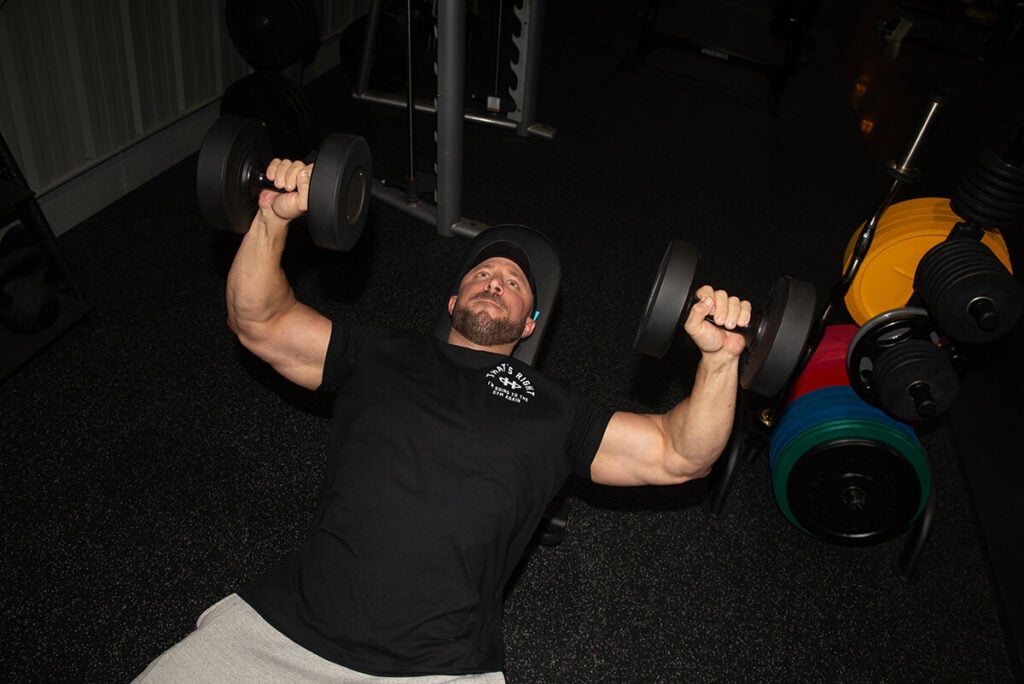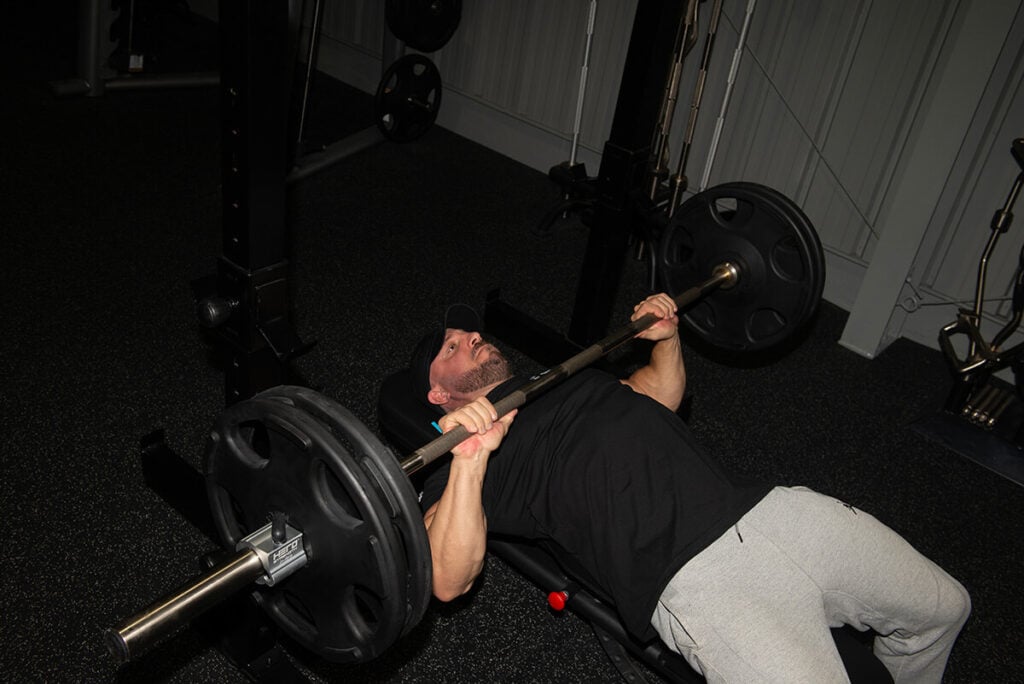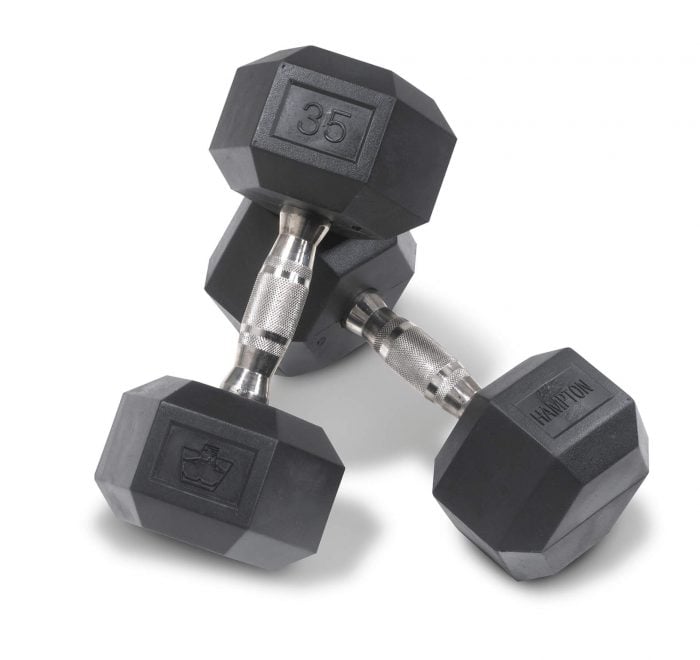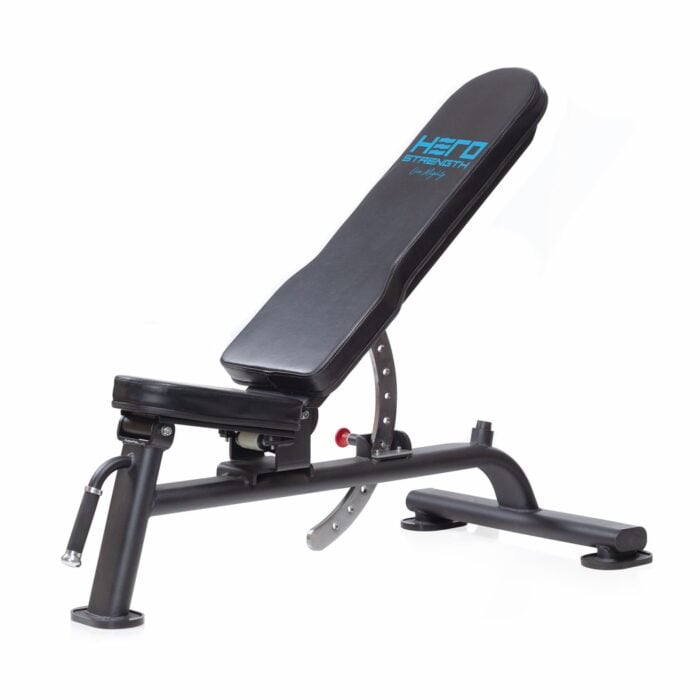If you aim to build strength and muscle in your upper body, two gold-standard exercises may come to mind: the dumbbell and bench press. They are similar, targeting the chest and arms, but they perform differently. Let’s look at each press method’s breakdown so you can better understand.
Key Takeaways
- Range of Motion and Muscle Activation: Dumbbell presses generally allow for a better range of motion than bench presses. This ROM can increase muscle activation, especially in the chest.
- Weight Capacity and Progressive Overload: Bench presses with a barbell typically allow you to lift heavier weights than dumbbell presses. This process can be beneficial for building strength and applying the principle of progressive overload.
- Safety and Equipment Needs: Dumbbell presses can be safer to perform without a spotter, as you can quickly release weights to either side without causing injury if the lifter reaches muscle failure.
Understand the Art of the Dumbbell Bench Press

The art of the dumbbell press is a conscientious blend of strength, control, and technique making this exercise effective and efficient. You can perform the dumbbell press on a flat bench, incline, or standing upright. Dumbbell presses are an essential staple of resistance training offering various benefits to both novices and advanced athletes.
At its core, the dumbbell press activates multiple muscle groups. The main target is the pectorals in the chest press. Deltoids are the primary target and a shoulder press. This compound movement engages the triceps, the rhomboids, and the serratus anterior. Its engagement across multiple muscles makes the dumbbell press an efficient and effective strength-building exercise. This exercise improves muscle mass and upper body power when you train consistently over time.
The dumbbell press can accommodate a broader range of motion than a barbell press. This increased range of motion allows for deeper stretches and more powerful contractions of the targeted muscles. This component enhances the overall effectiveness of this exercise.
The truest artistry of the dumbbell press includes mastering proper form. You must start with the correct alignment throughout your body and keep your dumbbells in line. It’s important to focus on controlled movements and ensure you’re lifting a challenging weight range that does not compromise your form. Knowing that you must breathe effectively throughout the exercise is also critical. Control your breathing by inhaling as you lower the weights and exhaling as you press them upward.
As you master the dumbbell press, you will realize it is more than a strength-building exercise. It is a display of balance, coordination, and power. The combination of strength and technique required makes the dumbbell press an art form in fitness.
Form
Proper form is critical to perform the dumbbell press safely and to ensure that you are effectively targeting the desired muscles.
Here’s how to perform a dumbbell press:
- Start by sitting on a bench with a dumbbell in each hand resting on your thighs. As you lie back, use your thighs to help lift the dumbbells. Hold the dumbbells at shoulder-width with your palms facing forward.
- Once you’re lying back, keep your feet flat on the floor. Bend your elbows at a 90-degree angle so the dumbbells align with your chest.
- Push the dumbbells up with your chest, extending your arms. Make sure to keep your shoulders and back pressed against the bench.
- Pause momentarily and slowly lower the weights until they’re at chest level. Remember to breathe in as you lower the weights and breathe out as you push them upward.
- Repeat for your desired number of reps.
Recommended products
-
Hampton Dura-Bell® Urethane Dumbbells – Pairs
$34.00 – $914.00 -
Hampton Adjustable Bench | J-Bench
$599.00 -
Hampton Jelly-Bell® Urethane Dumbbells – Pairs
$66.00 – $268.00
Equipment
The primary equipment needed for a dumbbell press is a pair of dumbbells. The weight of the dumbbells will depend on your current strength level, fitness goals, and the number of reps and sets you’re doing. In most cases, you want a weight that is challenging but still allows you to maintain proper form for the entire set.
Muscle Targeting
The dumbbell press primarily targets the pectoralis major or the chest muscles. But it also works a variety of other muscles:
- Triceps Brachii: These muscles at the back of your arms help extend your elbow joint or straighten your arm.
- Deltoids: The anterior (front) deltoids in your shoulders are secondary movers during the dumbbell press.
- Rotator Cuff: The small muscles in your shoulders, including the supraspinatus, infraspinatus, teres minor, and subscapularis, also get worked. They help stabilize your shoulder joints.
- Serratus Anterior: This muscle on the side of your chest is engaged when you fully extend your arms in the press.
- Latissimus Dorsi (Lats): Although not the primary target, your lats can also work as stabilizers during the dumbbell press.
What Makes an Effective Barbell Bench Press?

Form
The form is crucial in executing an effective bench press. Here are some guidelines to follow as you work toward safely mastering the bench press.
- Positioning: Lie on the bench with your feet flat on the floor. Your eyes should be directly under the bar.
- Grip: Grasp the bar with your hands wider than shoulder-width apart. Wrap your thumbs around the bar for a secure grip.
- Lift off: Unrack the bar by straightening your arms and moving the bar over your chest with your elbows locked.
- Lower the Bar: Bring the bar down to your mid-chest, keeping your elbows at about a 75-degree angle from your body. Do not let them flare out to the sides.
- Press: Push the bar back up to the starting position, focusing on using your chest muscles. Fully extend your arms, but avoid locking your elbows.
- Breathing: Take a deep breath at the start of the lift, hold your breath as you lower the bar, and exhale forcefully as you press the bar up.
Equipment
A sturdy flat bench and a barbell are the primary equipment for a bench press. You’ll need weight plates of varying weights to adjust the load. A power or squat rack to rack and unrack the barbell is highly beneficial. Safety bars in the rack can also provide a safety catch if you cannot complete a rep.
For heavy lifting, it’s great to have a spotter who can help you lift the barbell off the rack and be there to assist if you struggle with a lift.
Muscle Targeting
The bench press is a compound exercise that works several muscles at once. The primary muscles targeted in the bench press include:
- Pectoralis Major: These are your main chest muscles and the primary target of the bench press.
- Triceps Brachii: The triceps on the back of your upper arm help extend the elbow and are significantly involved in the bench press.
- Anterior Deltoids: These front shoulder muscles assist in lifting weight.
In addition, several other muscles are secondary movers or stabilizers, including the latissimus dorsi (lats), rhomboids, and various core muscles.
Proper execution of form, the use of appropriate equipment, and the correct targeting of muscle groups will all make or break your bench press.
As with all exercises, it is essential to start with manageable weights to master the form and gradually increase the weight to avoid injury and ensure continuous progress.
Which is Better, the Dumbbell Bench Press or the Barbell Bench Press?
The answer to this question depends!
The chest press and shoulder press are distinct exercises targeting different muscle groups. The chest press primarily works the chest muscles, particularly the pectoralis major, while the shoulder press focuses on the shoulder muscles, especially the deltoids. Both exercises also engage the triceps as a secondary muscle group.
Choosing between them depends on whether you aim to build chest strength or shoulder strength.
Let’s take a closer look at each variation.
Dumbbell Press Variations
Dumbbell Floor Press:
Perform this exercise by lying on the floor with a dumbbell in each hand. It targets the upper body muscles, especially the triceps and chest. You lower the dumbbells towards your chest, then press them back up until your arms fully extend.
Neutral Grip Dumbbell Bench Press:
In this variation, you hold the dumbbells with a neutral grip (palms facing each other) while performing the bench press. This grip can help to engage different muscles and reduce stress on the shoulder joint.
Reverse Grip Dumbbell Bench Press:
For this version, you hold the dumbbells with your palms facing toward you (opposite of the typical grip). This grip changes the activation of the muscles, emphasizing the upper pectorals and the biceps.
Crush Grip Dumbbell Bench Press:
This version is performed with two dumbbells pressed together throughout the exercise, engaging the pectoral muscles differently and recruiting the arms and shoulders muscles to maintain the ‘crush’ position.
Barbell Bench Press Variations
Incline Bench Press:
In this exercise, the bench is at an angle (usually 15 to 45 degrees), which targets the upper part of the chest and the shoulders more than the regular flat bench press.
Close Grip Bench Press:
This variation reduces the distance between your hands on the barbell. It’s a great way to increase tricep activation and engagement.
Wide Grip Bench Press:
By taking a wider grip on the barbell, you can emphasize the chest muscles, particularly the outer portion of the pectorals.
Floor Press:
The barbell floor press is similar to the dumbbell version but with a barbell. You lie on the floor and press the barbell until your arms fully extend and lower it back down. This process reduces the range of motion, which can help focus on the triceps and lockout portion of the press.
No Bench Yoga Ball Variation
Performing a bench press variation using a yoga ball, a stability ball, or a Swiss ball can add an extra element of core engagement and balance to your workout. Here’s how you can do it and what to consider for form, weight limitations, and safety.
Yoga Ball Press Form
- Start by sitting on the ball with your feet flat on the floor. The dumbbells should be on the ground next to you.
- Carefully pick up the dumbbells, lean back onto the ball, and walk your feet out until your upper back and shoulders gain support from the ball. Bend your knees at a 90-degree angle, and your body should form a straight line from your knees to your shoulders.
- Hold the dumbbells just outside of shoulder width with your palms facing away.
- Lower the dumbbells to the sides of your chest by bending your elbows, keeping them at about a 45-degree angle to your torso.
- Press the dumbbells back to the starting position, fully extending your arms but not locking your elbows.
- Repeat for the desired number of repetitions.
Yoga Ball Press Weight Limitations
Due to the instability of the yoga ball, it’s advisable to use lighter weights than you might typically use on a stable bench. You need to be able to control the weights at all times, mainly because falling or dropping them could lead to injury.
Yoga Ball Press Safety
- Check your alignment, ensuring your feet are firmly planted on the ground throughout the exercise to maintain balance.
- Avoid locking out your elbows at the top of the press to keep tension on your muscles and avoid potential joint stress.
- Be careful when getting into and out of the starting position, especially when holding weights. You can quickly lose your balance on the ball, risking injury.
- Use a quality exercise ball that can handle your body and lifting weights.
- Stay within the manufacturer’s weight recommendations for the exercise ball.
- Consider having a spotter nearby, especially if you’re new to this variation or using heavier weights.
- Ensure you have enough space to perform the exercise without hitting anything if you lose balance.
Working Out With Dumbbells
The dumbbell press allows for unilateral movement within your workout. Unilateral training means each side of your body will work independently and, therefore, help identify and correct any existing muscle imbalances.
The dumbbell press also improves the range of motion. Dumbbells allow for a broader range of motion, and in most cases, compared to a barbell press on a bench. This ROM can lead to increased muscle activation.
Dumbbells are also safer for those working out alone. It’s easier to drop a dumbbell safely than a barbell on a bench. Dumbbells are used more efficiently for variations like neutral grip or incline presses than barbells. Some gymgoers prefer that variation.
Always consult a fitness professional if you need clarification on performing a new exercise to ensure you do it safely and effectively.






